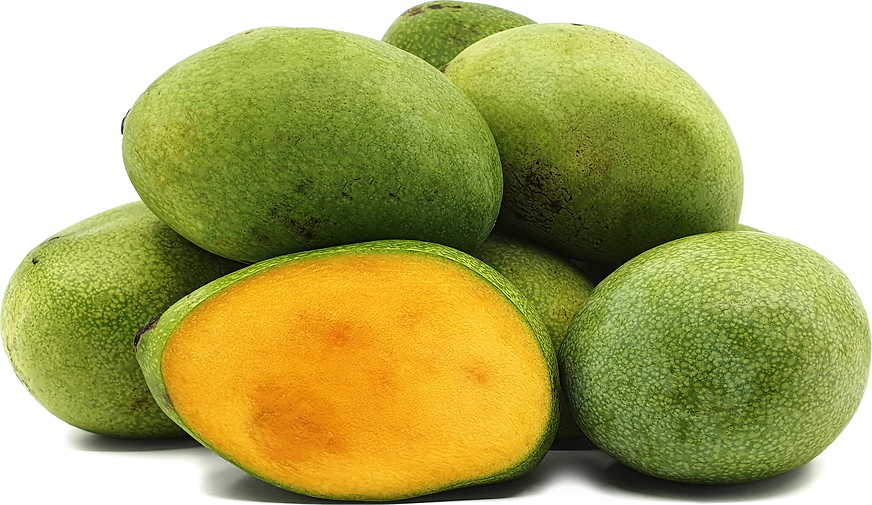


Yellow Manalagi Mangoes
Estimated Inventory, lb : 0
Description/Taste
Yellow Manalagi mangoes are small to medium-sized fruits, averaging 10 to 14 centimeters in length, and are round to oval in shape with curved ends. The skin is thick, waxy, covered in prominent white spots, and transforms from green to gray-green when ripe. Underneath the surface, the flesh is dense, golden-yellow to orange, aqueous, and fibrous, encasing a medium-sized, white seed. Yellow Manalagi mangoes are aromatic and have a very sweet, sugary, and tropical flavor with low acidity.
Seasons/Availability
Yellow Manalagi mangoes are available in the late summer through early fall.
Current Facts
Yellow Manalagi mangoes, botanically classified as Mangifera indica, are a very sweet variety that belongs to the Anacardiaceae family. The Indonesian cultivar is also known as Mana Lagi Mangga, and Manalagi roughly translates to mean "give-me-more mango," which stems from the cultivar’s popularity throughout Indonesia. Yellow Manalagi mangoes are favored as a versatile variety, primarily consumed fresh when mature, and utilized as a crunchy component in salads when young and firm. The fruits are widely available at fresh local markets and are a popular variety for their sweet, non-sour flavor.
Nutritional Value
Yellow Manalagi mangoes are a good source of vitamins A, B, D, and E and fiber, which can help regulate digestion. The fruits also contain beta-carotene, which is the orange pigment found in the flesh that is converted into vitamin A in the body, and provide some calcium, iron, phosphorus, and potassium, which is a mineral that can regulate fluid levels.
Applications
Yellow Manalagi mangoes are best suited for raw applications as their sweet, fibrous flesh is showcased when consumed fresh, out-of-hand. The fruits can be sliced and tossed into fruit bowls and green salads, sliced and layered over desserts, yogurt, and sticky rice, or blended into smoothies. Yellow Manalagi mangoes can also be dried or pickled for extended use, chopped into salsa, cooked into puddings, or mixed into ice cream. In Indonesia, young Yellow Manalagi mangoes are popularly sliced into sambal mangga, which is a condiment or relish that is commonly served with seafood. The fruits are also chopped into fresh fruit salads and are mixed with spicy, sour, and sweet flavors to create a complex side dish. Yellow Manalagi mangoes pair well with herbs such as mint, cilantro, and basil, scallions, chives, lemongrass, chile peppers, lime juice, ginger, bell pepper, cucumber, jicama, red onions, and peanuts. The fresh fruits should ripen at room temperature, and once ready for consumption, they can be stored whole and unwashed for an additional 5-7 days in the refrigerator.
Ethnic/Cultural Info
In Indonesia, Yellow Manalagi mangoes are frequently used young to make rujak buah, which is a sweet and spicy fruit salad. The immature fruits are used for their firm, crunchy consistency, and Yellow Manalagi mangoes are known for having a mild flavor even when unripe. There are many different variations of rujak, and the tangy salad is believed to be one of the oldest dishes in Java, commonly sold at local markets as a quick snack, dessert, or lunchtime meal. Rujak buah consists of freshly sliced fruits and vegetables that are tossed in dressings with chiles, tamarind, shrimp paste, salt, and sugar to create sour, spicy, and sweet flavors. The crunchy salad is also traditionally used in naloni mitoni or tujuh bulan, which is a ceremony held during the seventh month of pregnancy to wish a healthy and smooth birth for the mom and baby. During the ceremony, the expectant mother will eat rujak buah, and it is rumored that if she initially tastes sweet flavors, the baby will be a girl, and if she tastes spicy flavors, the baby will be a boy.
Geography/History
Yellow Manalagi mangoes are native to Indonesia and have been growing wild since ancient times. Today the yellow-fleshed fruits are widely found at local markets across Java and Bali and are primarily grown in the Probolinggo and Situbondo regions of East Java. Yellow Manalagi mangoes are also commonly grown in home gardens throughout Indonesia.




